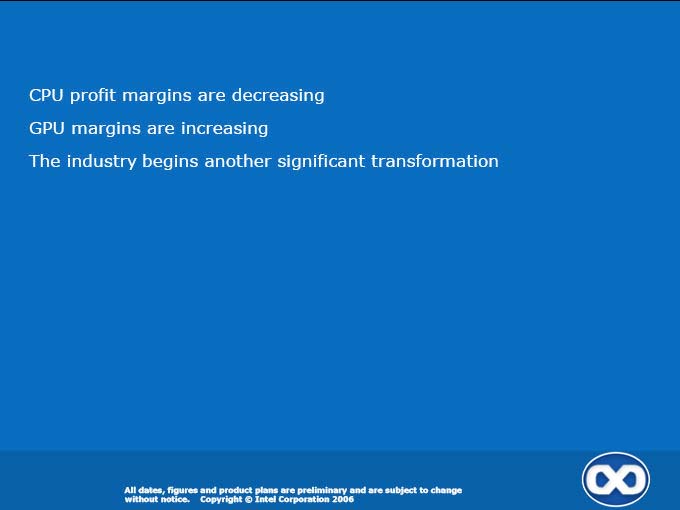The main thing though, Intel won't have an issue making the chip, but will they offset the margins of thier high end CPU production for lower margin GPU's on their best processes.
Unlike Nvidia, Intel has a track record of massively slicing into their margins in order to maintain (or bleed less) marketshare when they've deemed it necessary.
IE - Had Intel been in charge of the Geforce FX, it's average selling price would have been significantly lower than the Radeon 9700 Pro since Intel tends to avoid losing marketshare if at all possible.
So if it came down to a war of attrition, Intel would have a bit of an advantage.
However, I still doubt very much that Intel wants to bury Nvidia or take on Nvidia in the enthusiast class of graphics performance. And from the looks of it, neither does AMD. Leaving Nvidia to compete with Nvidia in the enthusiast class.
Where "I" personally believe Intel will target is HPC, specialized computing and the mainstream (perhaps even performance mainstream) with Larrabee. A similar market to what AMD is targetting with Rv670 and Rv770. Although I'm not sure how much effort AMD is putting at targetting HPC and specialized computing.
In those area's Intel has a great chance to succeed and gain marketshare from both Nvidia and AMD if they don't pull out and abandon it as they did back in the i740 days. Even if they end up making lower margins to do so.
After all, big OEMs love having systems with as many components from one manufacturer as possible. There's cost savings, support is easier and less costly, validation is generally simpler (and thus less costly), etc. There's a lot of benefits.
Although Nvidia does have going for it the fact that even IF the above were to come true (and it might not) many OEMs will still buy product from them just to maintain some bargaining position against Intel.
If this were anyone but Nvidia and Intel possibly coming to heads I'd say one or the other would win from pure marketing alone. However, both companies do a magnificent job marketing their products generally.
Intel also has a bit of an advantage in being able to put more pressure on OEMs through deals and discounts for other Intel Products (CPUs/Chipsets) if they were to bundle a "Larrabee GPU".
So even though Intel is at a disadvantage now, you just simple cannot discount or ignore them. And you can never ever say something is "impossible" in the tech world.
Once a company believes it's impossible for their competition to one up them, they've lost.
Regards,
SB

